-
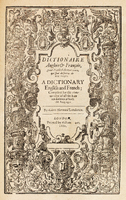
Susan Islip (fl. 1641-61) was the widow of Adam Islip (fl. 1591-1640). Widows often printed "useful" books such as this dictionary, which is less extensive than the dictionary with which it is bound.
-

This volume is purportedly a collection of Aesop, but most of the fables do not resemble Aesop in any way, and are political commentaries instead, written in the style of Aesop's fables. Baldwin's pamphlet, shown here, is full of Anti-Jacobite sentiments. However, there is another pamphlet, Aesop at Turnbridge, printed by Elizabeth Whitlock, included in this volume. These two women likely had some sort of dialogue in print between them, from opposite sides of the political spectrum.
-
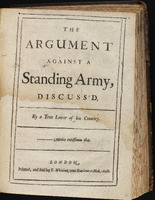
Ann Baldwin was not the only printer to take on social causes of her own accord. Elizabeth Whitlock (fl. 1695-99) succeeded her husband John (fl. 1683-95). The pamphlet shown here was printed in response to one printed by Baldwin, which is also bound into this volume. Because the topic at the time was so controversial (and in opposition to the King's views), many of the pamphlets in this particular volume do not list a specific printer. Whitlock, printing a pamphlet that sides with the King, was free to declare her involvement in the project.
-
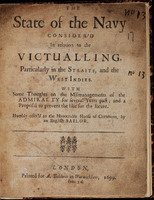
Ann Baldwin (fl. 1698-1711) was the widow of Richard Baldwin (fl. 1681-1698). While her husband was alive, Ann was active in the business, and controlled all of the accounts. It is likely that she also exerted some editorial control over what was published. The Baldwins were decidedly Whig publishers. Richard spent a good deal of time before the courts for his (their) "anti-Stuart, anti-French, anti-Papal" tracts and news-sheets," besmirching the names of James II and Louis XIV at every chance (Rostenberg 370, 372). His zealotry got him into a public brawl in 1681, fined in 1682, and jailed in 1690 (374, 378). Upon Richard's death, Ann continued to produce tracts, news sheets, satires, ballads and commentaries in the spirit of her husband (237 different publications over her tenure) (400). She was also very likely arrested in 1711 for her anti-Tory publications (402). Ann expanded upon her husband's single-mindedness, publishing a group of tracts, such as this one, that concerned social welfare--she was particularly concerned with the plight of English seamen, who had been abused by being served only rotten food.
-
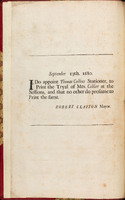
Elizabeth Cellier was an ex-Protestant who wrote a narrative describing her aid to imprisoned Catholics, and the horrific conditions of Newgate Prison. The narrative was suppressed, and she was then put on trial for having published libellious material against Charles II. She was fined one thousand pounds and pilloried for several days at different locations. At each location, copies of her libellious narrative were burned. Malice defeated is part of the Baskette Collection, a collection of materials that were challenged or suppressed in some way for their content.
-
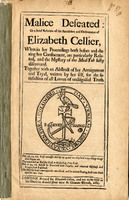
Elizabeth Cellier was an ex-Protestant who wrote a narrative describing her aid to imprisoned Catholics, and the horrific conditions of Newgate Prison. The narrative was suppressed, and she was then put on trial for having published libellious material against Charles II. She was fined one thousand pounds and pilloried for several days at different locations. At each location, copies of her libellious narrative were burned. Malice defeated is part of the Baskette Collection, a collection of materials that were challenged or suppressed in some way for their content.
-
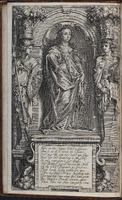
Anne Maxwell (fl. 1665-75) was the widow of David Maxwell (fl. 1659-65). She inherited two presses, three compositors, and three pressmen from her husband. Margaret Cavendish was a maid of honour to Henrietta Maria, and upon her marriage to the duke, William, devoted her life -and that of her maids, required to be ready to take down her ideas-to writing. She is most famous for her Life of William Cavendish, published by Anne Maxwell in 1667.
-
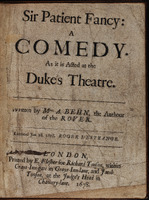
Aphra Behn (1640-1689) was one of the earliest British female dramatists and novelists to become popular. Before becoming a writer, she served the court of Charles II for a time as a spy in the Netherlands, where her work was disregarded. She was buried in Westminster Abbey. Elizabeth Flesher printed this volume for the Tonsons, who were printers and booksellers involved in the publication of important literary milestones such as Paradise Lost, and works by authors such as Dryden, Addison, Steele, and Pope. While this volume is mentioned in Plomer as one of Richard Tonson's "milestones," Elizabeth Flesher is never mentioned as being involved.
-
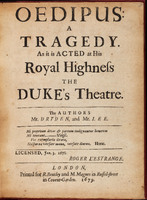
Richard Bentley (fl. 1675-97) was a well-known publisher of plays, novels, and romances. Several members of the Magnes family were his partners. Mary Magnes (fl. 1677-90?) is likely the widow of James Magnes (fl. 1660-79) who had been the senior partner in the publishing firm with Bentley.
-
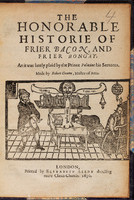
An edition of a contemporary play printed by Elizabeth Allde, "As it was lately plaid by the Prince Palatine his Seruants." The woodcut on the title page reads "Time is/Time was/Time is past," showing a musician, a scholar, and a third figure, possibly an astronomer. Like her late husband, Elizabeth Allde favored a quarto format, instead of octavos.
-
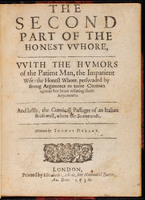
The basis of this moral play is that a reformed courtesan refuses to return to her former profession, despite temptation. The printer's device on the title page is likely that of Elizabeth Allde's late husband Edward (fl. 1584-1628), a trade printer for several publishers. Elizabeth (fl. 1628-40) continued the business after her husbands' death, printing ballads and popular plays as a trade printer. Nathaniel Butter (fl. 1605-64) was a bookseller, who published popular literature, and in 1639 focused exclusively on news sheets. Butters' play copyrights were given to Miles Flesher.
-
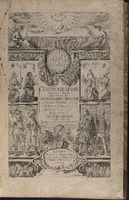
Peter Heylyn (1599-1662) was a strong proponent of British exploration, especially of the Americas. This large tome, published after his death, is not only a history and travel book, but an enticement to its readers to support exploration and colonization by the British government. Anne Seile (fl. 1661-69) was likely the widow of Henry Seile (fl. 1619-1661), a bookseller. George Sawbridge (1647-81), Thomas Williams (fl. 1662-67), Henry Brome (fl. 1657-69), Thomas Basset (fl. 1659-93), and Richard Chiswell (fl. 1666-1711) were all booksellers and publishers as well. A book such as this would have been expensive to produce, thus necessitating the involvement of so many publishers. It is likely, however, that Seile was in charge of coordinating the printing, since she is given primary "billing" on the title page.
-
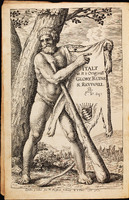
Sarah Griffin produced this book for Henry Twyford (fl. 1641-75), Thomas Dring (fl. 1649-68), and John Place (fl. 1645-86), all booksellers who dealt primarily in law books. The engraved maps were printed separately from the text and tipped in. All of the ornamentation included within the text was produced using woodcuts.
-
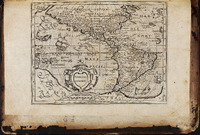
This is the only extensive work on South America by an Englishman of the period. Ellen Cotes (fl. 1653-70?) was the widow of Richard Cotes (fl. 1635-52). John Sweeting (fl. 1639-61) was a bachelor bookseller who sold mostly poetry and popular literature.
-

Heavily illustrated books on heraldry and emblem books had been popular for over a century when this item was printed. The engraved larger plates have been tipped in; smaller illustrations appear to be printed from woodcuts.
-
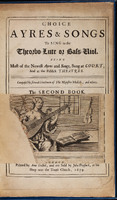
Anne Godbid and John Playford worked as partners to print music, a format which was considerably more difficult to produce than text. The music included in this volume was not composed by Playford, merely collected by him, and printed after the success of an earlier, similar book. While music printed from engraved plates began appearing in England in 1613, this music seems to be printed from movable type, using woodblock initials for ornamentation.
-
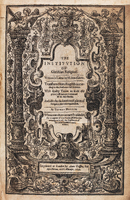
This seminal text by Calvin, in such a large format, was no small undertaking for any printer. Anne Griffin, as a relatively wealthy widow, was likely one of the few printers who could afford to do so, and in this case, took on partners as well. Joyce Norton (fl. 1632-37) was possibly the widow of John Norton, a printer who died in 1612. She also printed in partnership with Richard Whitaker (fl. 1619-48), a prominent bookseller.
-
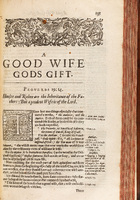
Another example of a moral sermon directed towards women. Edward Brewster (fl. 1621-1647) specialized in theological works. Fulke Clifton (fl. 1620-1644) specialized in broadsides and political pamphlets, which makes his commission of this particular work interesting. The notes are in Greek and Latin, easily accomplished by an established printing house such as Anne Griffin's, which would likely own several fonts of type.
-
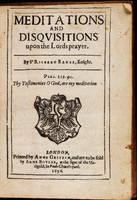
This text is another example of women working together to print and disseminate literature. Anne Boler (fl. 1635-7), continued the work of her late husband, James (fl. 1626-35), selling primarily theological works in St. Paul's Churchyard, one of the centers of printing and bookselling in London. Anne Griffin (fl. 1634-43) was the widow of Edward Griffin I (fl. 1613-21). In 1643, Griffin was reprimanded by the Company for publishing Thomas Becon's Displaying of the Popish Mass, an item which the Archbishop Laud, the sanctioned censor at the time, wished to repress.
-
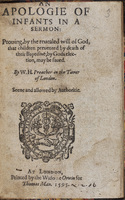
This sermon on baptism was likely aimed at a female audience-mothers who were urged to baptize their children. This book, printed by the Widow Orwin, was printed for Thomas Man (fl. 1576-1625), a prominent bookseller, highly active in the Company, who specialized in theological materials.
-
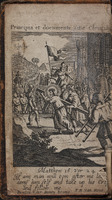
Mary Clark printed this moral instruction book for Henry Brome, who also worked with her late husband, Andrew. Joanna Brome, Henry's widow, later carried on his business.
-
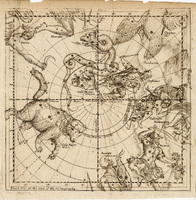
Our copy of this edition has had a great deal of conservation work, and was disbound. The book is notable for its maps and figures, which take a good deal of skill to print. Anne Godbid (fl. 1678-1683) was the widow of William Godbid, (fl. 1656-77) who, in partnership with John Playford, printed a good deal of music.
-
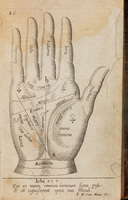
This book, which teaches "drawing, limning, and painting" is notable for the many engraved illustrations included. Margaret White (fl. 1678-83), the printer, is only listed briefly as a bookseller in Plomer.
-
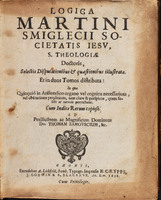
A scholarly book on logic with printed annotations in the margins. Anne Lichfield (fl. 1657-59) was the widow of Leonard Lichfield, the University printer at Oxford (fl. 1635-57). Leonard Lichfield was "a staunch Royalist, and was described in Puritan tracts as the 'malignant printer'" (Plomer 117). His imprint was frequently forged for books published in London. Upon his death, Anne and her son, also named Leonard, were appointed University printers.
-
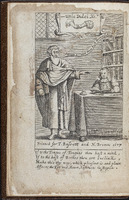
A basic Latin textbook, which uses biblical passages to teach not only Latin but morals. Joanna Brome continued the bookselling and publishing business of her husband, Henry (fl. 1657-1681) for two years, until their son, who may have been either Charles or Henry Brome, took over.
























